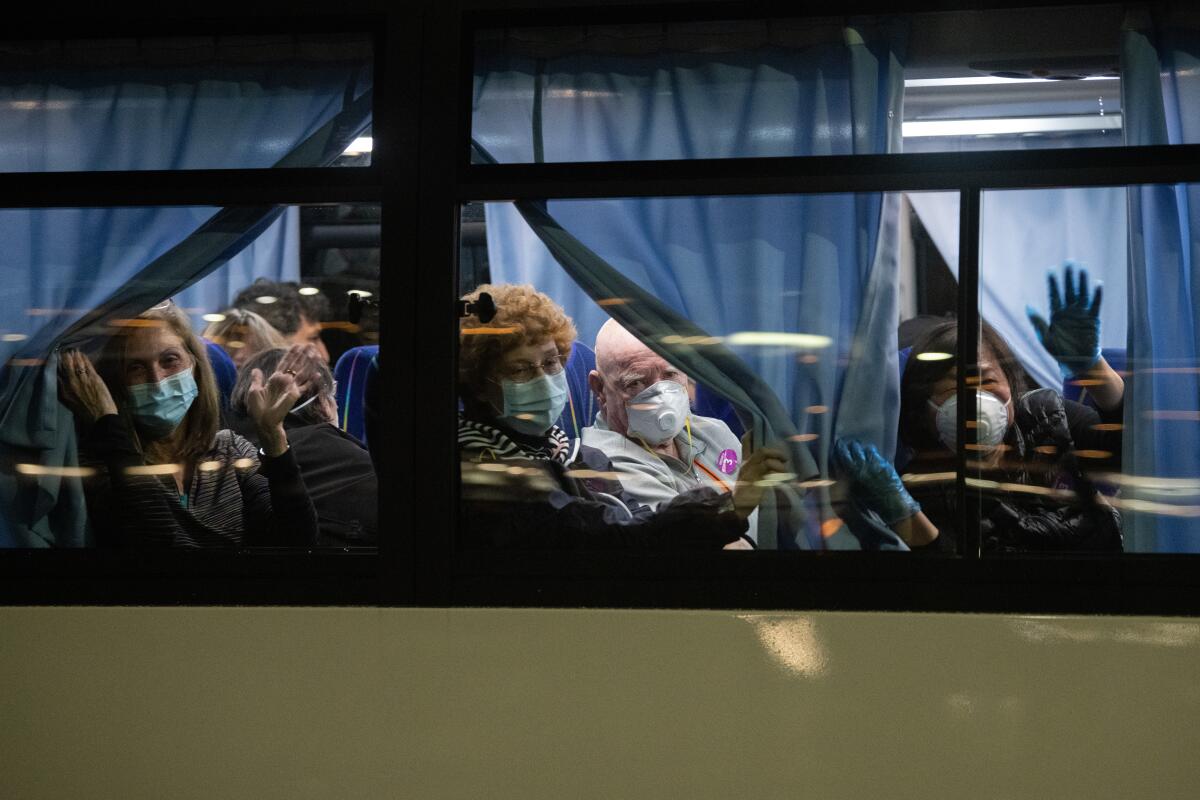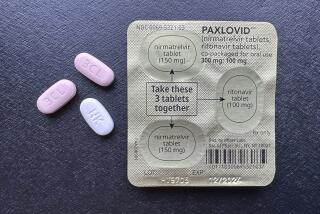Q&A: What can the government force people to do in the name of containing the coronavirus?

- Share via
The new coronavirus from China has infected at least 86 Americans and resulted in two deaths. Some of those who were sick had not traveled outside the country or been in contact with anyone who had — an ominous sign that the outbreak has entered a dangerous new phase in the United States.
Here’s a look at some of the legal tools federal, state and local governments have at their disposal to contain the spread of COVID-19.
What policy measures are available to stop the spread of disease in the United States?
From the nation’s borders to the thresholds of our homes, public health officials have a range of options for slowing or stopping the spread of an infectious disease. Think of it as a layered defense. Generally speaking, as those measures get closer to home, they sweep in more people and become more controversial.
When a virus crops up outside U.S. borders, screening people as they arrive at airports and other entry points is often a first step. It’s rarely controversial, and it’s widely thought to calm public jitters.
But looking for signs of illness in air travelers, cruise ship passengers and border crossers can be of limited value when it takes a day or more for an infected person to show the first signs of illness, as is typically the case.
What about if the disease is already here?
Once a disease reaches the U.S., health officials work to identify and isolate those who have been exposed. To avoid spreading the virus to others, these people are asked to sequester themselves for days or weeks, depending on the time it takes for an exposed person to show signs of infection.
Public health officials will also begin the painstaking process of tracing the people each infected patient has been in contact with since contracting the virus. Officials will check in with both the patient and his or her contacts on a daily basis. If any of the contacts becomes sick, they will be asked to sequester themselves and the process will be repeated.
Not everyone stays home when asked, and not everyone either reveals or remembers each person they’ve been in contact with. State laws vary, but failure to comply can carry minor criminal penalties — a stick rarely used by public health authorities. The result: A virus may find ways to spread within a community. With COVID-19, that threshold was crossed last week.
What are the options then?
At some point, widespread person-to-person transmission is likely to outstrip the ability of public health officials to track every exposed person and all of their contacts. Instead, they’ll shift their focus to broader swaths of people, including many who would never likely have been exposed.
Initially, they may ask groups at higher risk of infection — all healthcare workers who may have been exposed to patients with the disease, for example — to stay home voluntarily. Canada did this in 2003, when the SARS virus began to spread there.
Other measures will go further, affecting some who have no reason to think they’ve been infected. And they may begin to limit a population’s movements and choices.
Voluntary “social distancing” measures may be recommended. Worship meetings and other large gatherings would be discouraged. If they went on anyway, vulnerable populations would be lobbied to skip them. In areas where community transmission is high, schools may be closed and businesses may ask employees to work from home.
What is the federal government legally authorized to do?
The 2010 Public Health Service Act authorizes the federal government to prevent the entry and spread of communicable diseases from foreign countries into the United States, as well as between states.
That gives the feds pretty broad latitude. Officials at the Centers for Disease Control and Prevention have the power to stop travelers — both foreigners and American citizens — arriving on ships, airplanes and over land. If necessary, travelers may be isolated or quarantined at one of 20 designated quarantine stations.
According to an executive order last updated in 2014, the infectious diseases that could prompt CDC to isolate or quarantine an individual are: cholera, diphtheria, infectious tuberculosis, plague, smallpox, yellow fever, viral hemorrhagic fevers, severe acute respiratory syndromes, and new types of flu that could cause a pandemic. COVID-19 is covered under that list because it causes a severe acute respiratory syndrome.
Washington also has the power to recommend mandatory vaccination and to determine which groups should get first dibs on the vaccines or drugs that are in short supply. But as a constitutional matter, states can make their own rules on such matters.
What power does the federal government have over states?
In principle, if the federal government felt it were necessary to prevent a disease from spreading between states, it could place limits on interstate travel or commerce. But this has never happened, according to Lawrence Gostin, an expert on health law at Georgetown University.
The CDC assists state and local authorities with expert advice and relies on them to respond to local circumstances, as well as to carry out and enforce federal orders if necessary. The federal government has long used its broad powers sparingly, Gostin said, because detaining or impeding people’s movements without due process can invite challenges.
In addition, the federal government can stockpile medicines and supplies that it deems essential, such as ventilators, vaccines and anti-viral drugs. It can distribute those as it sees fit, which gives it some sway.
What’s the difference between quarantine and isolation?
Quarantine is reserved for people who may have been exposed to a communicable disease but who are not (yet) sick. It’s a practice that the port of Venice established in the 14th century, when the Black Death raged: Inbound ships would be made to anchor offshore for 40 days (hence the Italian, quaranta) to give any disease that might be onboard time to show itself and run its course. Only then would sailors be permitted to disembark.
When separated from the general public for a period of time that’s as long as the incubation period for a disease, those who have been quarantined are less likely to spread it. And if they do become sick while in quarantine, they can be swept into isolation and treated quickly.
Isolation is what happens when a person is separated from others because he or she is confirmed to be infected and has developed symptoms.
How often does the federal government use its quarantine power?
On Jan. 31, CDC officials initiated a 14-day quarantine of 195 Americans who were transported from Wuhan, China, to March Reserve Airbase in Ontario. It was the first time the federal government had exercised that power in decades.
During World War I, federal authorities detained tens of thousands of prostitutes in a bid to curb the spread of sexually transmitted diseases. There were local uses of quarantines during the 1918 influenza epidemic. Until January, the most recent use of federal quarantine power was in the 1960s, when the government detained an individual with a suspected case of smallpox. (It turned out that the person did not have smallpox.)
Can the government force people who are sick to stay home or isolate themselves?
In principle, the federal government can impose quarantine and isolation orders. But it doesn’t seem keen to test that power.
It’s probably not a coincidence that the first people to be quarantined after leaving Wuhan were largely State Department employees and their their relatives.
“This is a part of their civic responsibility to protect their communities,” Dr. Martin Cetron, who directs CDC’s Division of Global Migration and Quarantine, told reporters when the quarantine began. “So, they understand this.”
Cetron downplayed the need for the federal government to flex its muscles in issuing quarantines.
Is the public likely to comply with those orders?
Canada’s experience of asking some healthcare workers to stay home during the SARS epidemic suggests that when they’re properly informed, people “are usually very compliant with this request to restrict their movement,” he said. “The best way to enforce a quarantine is to educate people on its purpose and educate what the benefits are for the individuals who cooperate,” including rapid diagnosis and care if they become sick.
In 2007, nearly 9 in 10 Americans told survey-takers that if asked, they would abide by a voluntary quarantine and stay home during a flu pandemic. Among the 10% who said they would not adhere to a voluntary appeal, 64% cited concern over losing needed income and 39% said they feared losing their jobs altogether.
In a country where individual rights often trump considerations of communal welfare, an appeal to “do the right thing” may not be enough. When one person aboard that first flight of evacuees sought to leave March Airbase in defiance of the quarantine order, the CDC had California’s Department of Public Health issue a quarantine order of its own.
That highlights a key point about CDC’s powers of quarantine: The agency has no means of enforcement and typically relies on state or local officials to carry out its orders.
Could the government require schools or businesses to close?
Probably not. When it comes to decisions such as the closure of schools or workplaces, the CDC’s powers are entirely those of expertise and persuasion. Education and commerce are, for the most part, under the jurisdiction of state and local authorities.
If the federal government were to use its powers to limit interstate commerce or travel, that move would be unprecedented.
How much power do state and local governments have?
It varies from state to state. But most state legislatures have granted governors or county executives the power to impose quarantines or other measures to block the spread of disease, and have designated state and local authorities to enforce those powers.
When it comes to using those powers, political officials have tended to be more hard-charging than the CDC. In 2014, when healthcare workers began returning to the United States after helping West African nations fight the Ebola virus, several states raced to put them in quarantine despite protests from civil rights activists.
New York and New Jersey responded to the return of an Ebola-infected healthcare worker by declaring 21-day quarantines for doctors and nurses who had treated patients in Sierra Leone, Guinea and Liberia. Maine, Minnesota and Georgia announced three-week quarantines for some travelers from Africa, including those with no symptoms. And Pennsylvania, Florida and Virginia announced enhanced screening of travelers from West Africa and asserted their right to ban some of them from using public transportation within their borders.
Dr. Thomas Frieden, the director of the CDC at the time, issued recommendations against such strictures. He argued that they would lead airline passengers to conceal their travel histories, which could make life difficult for epidemiologists. It would also discourage American medical workers from fighting Ebola abroad so that it wouldn’t come here.
States’ rights won the day.
Can state and local governments decline to cooperate with federal authorities?
Yes, they could.
Already, local governments have sought to buck the federal government’s plans to quarantine residents returning from China. A plan to use a state-owned facility in Costa Mesa for that purpose has drawn a lawsuit aimed at blocking California’s implementation of the CDC plan. The Orange County Board of Supervisors, concerned that the CDC could designate a shuddered Santa Ana facility to quarantine returnees, signaled that it would fight such a move in court as well. The feds opted to drop the plan.
California’s Department of Public Health is carrying out the CDC’s quarantine plan. So technically, this fight pits local authorities against the state. But the federal government will have a powerful voice in defending its quarantines.
Gostin said the CDC’s past reluctance to use quarantines might give the federal government the upper hand in this case.
“As a legal matter, the federal government has a right to quarantine at the border,” he said. “It can be appealed. But the courts are likely to uphold the quarantine, and they should.”







